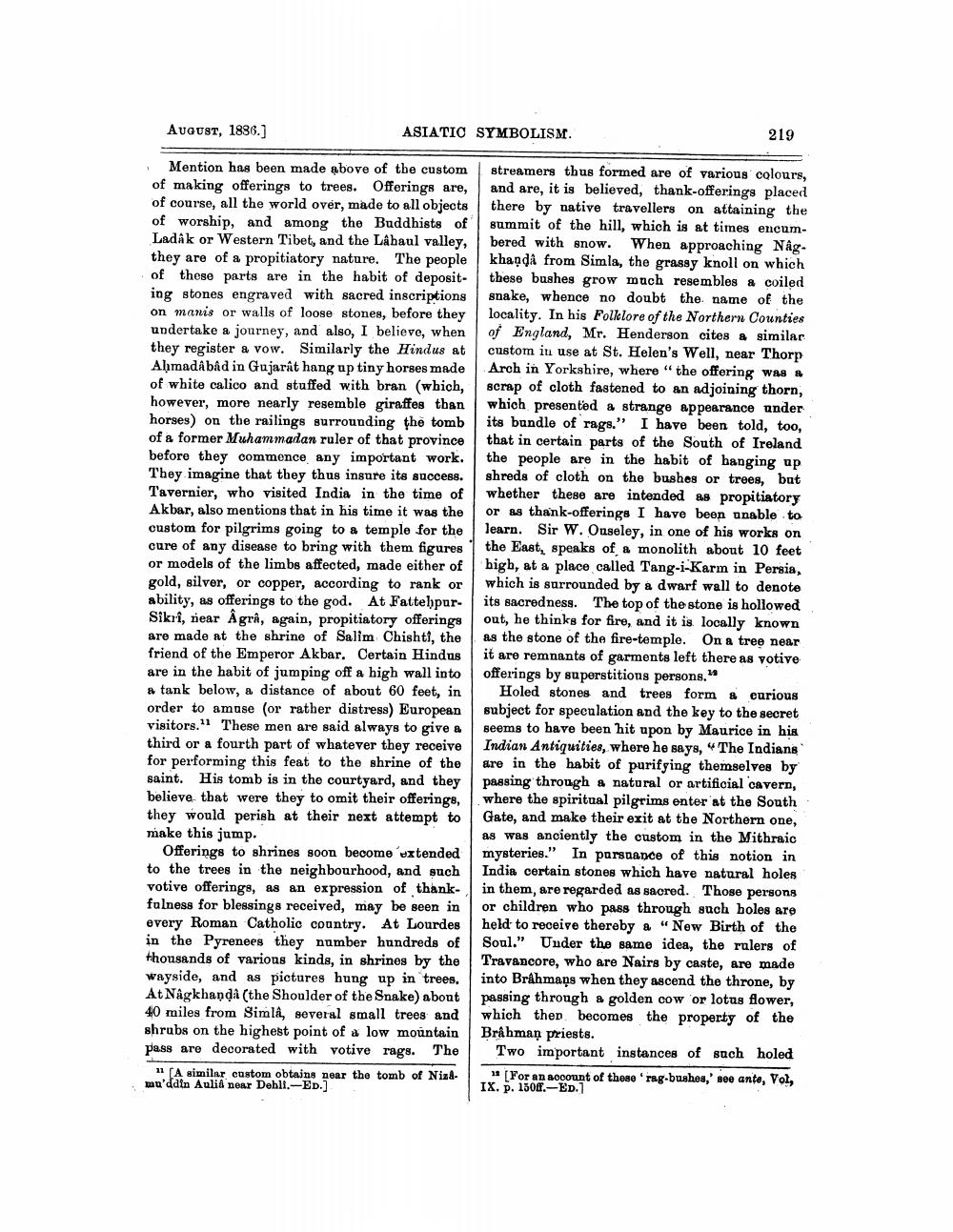________________
AUGUST, 1836.)
ASIATIC SYMBOLISM.
219
Mention has been made above of the custom of making offerings to trees. Offerings are, of course, all the world over, made to all objects of worship, and among the Buddhists of Ladak or Western Tibet, and the LÂbaul valley, they are of a propitiatory nature. The people of those parts are in the habit of depositing stones engraved with sacred inscriptions on manis or walls of loose stones, before they undertake a journey, and also, I believe, when they register a vow. Similarly the Hindus at AhmadAbad in Gujarat hang up tiny horses made of white calico and stuffed with bran (which, however, more nearly resemble giraffes than horses) on the railings surrounding the tomb of a former Muhammadan ruler of that province before they commence any important work. They imagine that they thus insure its success. Tavernier, who visited India in the time of Akbar, also mentions that in his time it was the custom for pilgrims going to a temple for the cure of any disease to bring with them figures or models of the limbs affected, made either of gold, silver, or copper, according to rank or ability, as offerings to the god. At FattehpurSikri, near Agra, again, propitiatory offerings are made at the shrine of Salim Chishti, the friend of the Emperor Akbar. Certain Hindus are in the habit of jumping off a high wall into a tank below, a distance of about 60 feet, in order to amuse (or rather distress) European visitors. These men are said always to give a third or a fourth part of whatever they receive for performing this feat to the shrine of the saint. His tomb is in the courtyard, and they believe that were they to omit their offerings, they would perish at their next attempt to make this jump.
Offerings to shrines soon become 'uxtended to the trees in the neighbourhood, and such votive offerings, as an expression of thankfulness for blessings received, may be seen in every Roman Catholic country. At Lourdes in the Pyrenees they number hundreds of thousands of various kinds, in shrines by the wayside, and as pictures hung up in trees. At Nagkhanda (the Shoulder of the Snake) about 40 miles from Simlê, several small trees and shrubs on the highest point of a low mountain pass are decorated with votive rage. The
11. (A similar custom obtains near the tomb of Nizd. muddin Aulid near Debli.-ED.]
streamers thus formed are of various colours, and are, it is believed, thank-offerings placed there by native travellers on attaining the summit of the hill, which is at times encumbered with snow. When approaching Nâgkhandå from Simla, the grassy knoll on which these bushes grow much resembles a coiled snake, whence no doubt the name of the locality. In his Folklore of the Northern Counties of England, Mr. Henderson cites a similar custom in use at St. Helen's Well, near Thorp Arch in Yorkshire, where "the offering was a scrap of cloth fastened to an adjoining thorn, which presented a strange appearance ander its bundle of rags.” I have been told, too, that in certain parts of the South of Ireland the people are in the habit of hanging up shreds of cloth on the bushes or trees, but whether these are intended as propitiatory or is thank-offerings I have been unable to learn. Sir W. Onseley, in one of his works on the East, speaks of a monolith about 10 feet high, at a place called Tang-i-Karm in Persia, which is surrounded by a dwarf wall to denote its sacredness. The top of the stone is hollowed out, he thinks for fire, and it is locally known as the stone of the fire-temple. On a tree near it are remnants of garments left there as votive offerings by superstitions persons."
Holed stones and trees form a curious subject for speculation and the key to the secret seems to have been hit upon by Maurice in his Indian Antiquities, where he says, "The Indians are in the habit of purifying themselves by passing through a natural or artificial cavern, where the spiritual pilgrims enter at the South Gate, and make their exit at the Northern one, as was anciently the custom in the Mithraic mysteries." In parsnance of this notion in India certain stones which have natural holes in them, are regarded as sacred. Those persons or children who pass through such boles are held to receive thereby a "New Birth of the Soul." Under the same idea, the rulers of Travancore, who are Nairs by caste, are made into Brahmaṇs when they ascend the throne, by passing through a golden cow or lotus flower, which then becomes the property of the Brahmaņ priests. Two important instances of such holed
[For an account of these 'rag-bushes,' see anto, Vol, IX. P. 1500.-ED.




